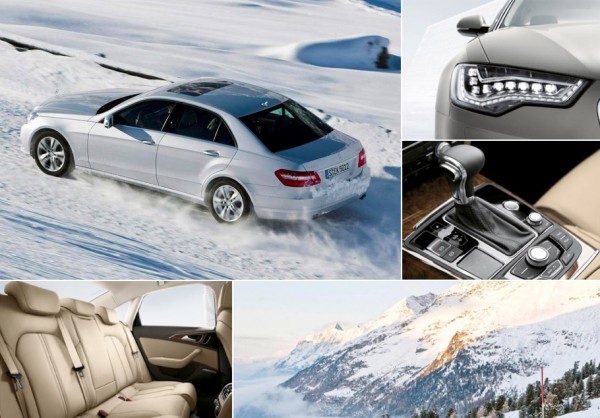In Russia, winter is
an unavoidable fact of life.
Luckily, it comes around only once a year on average.
Unluckily, it tends to go on for quite a long time.
Each year russians thus face several months of snow, ice and something in between which makes life a bit more complicated during this time of year.
This is especially noticeable if you drive a car. Road conditions are likely to be slippery as well as dirty, which is bad news for everybody except «Moika» owners. So to get through these wintery conditions, one is well advised to keep a few things in mind when buying a car. Which car would I rather drive during winter? Certainly the benefits of all wheel drive models are difficult to ignore. With excellent traction you are unlikely to get stuck, which can save you quite a lot of snow-shoveling labour over the course of winter. Rear wheel drive cars can be fun to drive in snow as well, you can spend most of the time driving sideways, but when you just want to get from A to B that can get old after a while. And after a heavy overnight snow shower you are looking at some hard work in the morning to get going. Front wheel drive cars finally will have superior traction compared to their rear wheel driven cousins, but are generally uneventfully average to drive. Some would say boring.
My ideal winter car then would have to be all wheel drive. And of course a big powerful engine would be nice. And if it’s not too much to ask, a really good interior and good looks.
As it turns out, Audi has just released a new S6,
does it tick all the boxes?
![]()
«The 2012 S6 comes with an all-new turbocharged V8 engine with direct injection..»
![]()
«…and features the 6th generation Quattro all-wheel-drive to keep the power on the road»
Well to start, it has arguably the world’s most well known 4 wheel drive system: Quattro. This is a permanent all wheel drive system that delivers power to all 4 wheels simultaneously by using several differentials to distribute power to the 4 wheels. By the way, the first Audi to use the «Quattro» system was called… «Quattro» and it was launched back in 1980. The car is now referred to as «Ur-Quattro» whith «Ur» loosely translating into «ancient». At the time it was certainly revolutionary, and even now more than 30 years later it is still the industry standard. Of course there have been several improvements made since then, the new S6 has 6th generation Quattro.
As you guys know, the «S» in S6 stands for sport and in practical terms this means a big powerful engine, an upgraded interior and some small visual clues to the car’s exterior that this is not a regular A6, but it is all very dignified. Also standard is adaptive air suspension which promises good ride comfort without sacrificing handling. The S6 is available both as a sedan or wagon, «Avant» in Audi terms which sounds a bit sexier possibly because it has no reference to trains. Both offer identical interior space, but the Avant has considerably more space in the back, enough to fit several St. Bernard dogs if required.
![]()
It has a newly developed engine that produces 420 horsepower and offers better overall performance than the old 450hp V10, whilst using up to 25% less fuel. If you are wondering how 420 beats 450, the answer lies in torque. Because of the turbochargers, the new engine produces much more power at low engine speeds which is important for the car’s performance. The only sacrifice has been engine sound. The new V8 certainly sounds good, but is no match for the symphony of the old V10. There is some price for progress after all. But the new engine really is packed with clever new technologies, it will even go so far as to run on 4 of its 8 cylinders when conditions allow in order to use less fuel. We also expect a slightly modified version of this engine to appear in the next RS6, where it will be delivering well over 500 horsepower.
Talking performance, it will reach 100 km/h in less than 5 seconds and is limited by computer to 250 km/h. I think we can all agree that reaching such speed in a snowy Russian environment is unlikely, but it’s somehow reassuring to know that the car has some spare capacity for speed. For example you could find yourself on the unrestricted German autobahn searching for the nearest bathroom, you just never know when all that power will come in handy.
Though while Audi is certainly well known for Quattro, its German rivals have also been doing a lot of R&D into all-wheel drive systems a bit more recently. BMW has what it calls «X-drive» and Mercedes has «4matic», Both systems are offered optionally on many of their models just like Audi’s Quattro.
In terms of competing models you would probably put the S6 next to a BMW 550xi or Mercedes E500 4matic. They offer similar quality and interior space, but are geared a bit more towards outright comfort where the S6 makes a limited effort to be more sporty. That said, it is possible to live happily ever after with each of these cars.
![]()
«BMW has made big steps in recent years to bring its Xdrive all-wheel-drive system to a very high level»
![]()
«A great long distance cruiser, the E-class is both fast and comfortable. 4matic functions very well without winning any prizes»
![]()
«The G37 offers great value for money. It’s fast and reliable, even if it doesn’t turn many heads»
Of course you don’t necessarily have to go shopping with German brands. There are some luxury cars coming out of Asia that have reliability ratings the Germans can only dream about. Subjectively, and as an auto enthusiast I would say that probably they lack a bit of emotion or spirit, but they have advantages as well that are difficult to ignore.
Staying with the winter theme, the Infinity G37x would probably be my non-German car of choice. It has a lovely sounding V6 engine that produces well over 300 horsepower and although its interior is not quite as «premium» as the cars we mentioned earlier, it’s still a nice place to be in. It’s considerably cheaper as well.
All-wheel-drive and a lot of horsepower..
It could almost make you look forward to the Russian winter. Almost.











